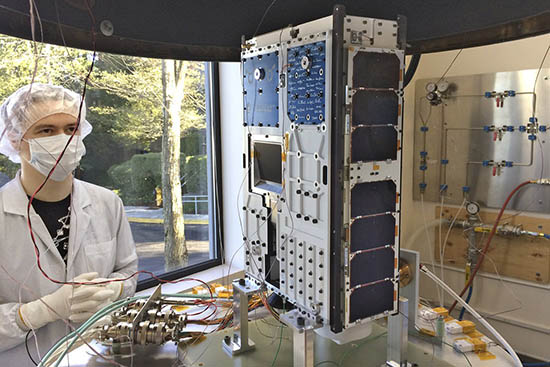太空采礦業有望成為現實
|
在小行星上采礦或取水都不是什么天方夜譚。在三年前的一次訪談中,天體物理學家尼爾·德格拉塞·泰森就說過,地球上的第一位億萬富翁將是“那個在小行星上開采自然資源的人”。 很多創業者都在進行嘗試。最引人注目的是成立于2012年的太空采礦初創公司Planetary Resources,它的投資人包括電影導演詹姆斯·卡梅隆以及谷歌的聯合創始人拉里·佩奇。 2018年年初,Planetary Resources一飛沖天。當時它剛剛發射了一顆自行設計的全新微型衛星,這顆衛星可以通過中波紅外熱成像儀發現地球大氣以外的水資源。這是該公司的第一步,它的長期目標則是最終拿下首個小行星采礦權。 |
Mining asteroids for either the minerals they contain or the water they hold isn’t some outlandish fantasy. In an interview three years ago, astrophysicist Neil deGrasse Tyson said that Earth’s first trillionaire would be “the person who exploits the natural resources on asteroids.” A number of entrepreneurs are taking their shot. The splashiest space-mining startup, Planetary Resources, was founded in 2012 and boasts investors including movie director James Cameron and Google cofounder Larry Page. At the start of 2018, Planetary Resources was literally flying high. It had just launched a brand-new miniature satellite of its own design, one that would use a mid-wave infrared imager to sniff out sources of water beyond Earth’s atmosphere. It was the first step toward its longer-term mission to eventually stake the first asteroid-mining claim. |

|
兩年前,Planetary Resources融資2100萬美元,隨后又通過與盧森堡政府簽署合作伙伴協議獲得2800萬美元資金——盧森堡想成為行星際采礦所有相關事務的地面樞紐。 但這家設在華盛頓州雷德蒙德的商業太空創業公司很快就發現自己陷入了困境——融資不足導致裁員。據說其員工人數從大約70人減少到了10人左右,而且還向盧森堡政府轉讓了10%股權。到了8月底,該公司的首席執行官克里斯·萊維茨基已經在打算拍賣筆記本電腦等設備了。萊維茨基拒絕就本文接受采訪。 雖然小行星采礦可能是個很賺錢的行當——高盛集團的一篇報告估算,一顆小行星上就可發現價值高達500億美元的鉑金,但此項業務面臨的技術問題尚未得到解決。外部觀察人士指出,所有打算上太空采礦的公司最好都要為長期等待做好準備。 科羅拉多礦業學院的一位太空資源課程教授喬治·索爾斯說:“開創這個全新領域會遇到很多障礙,所以任何對此抱有雄心壯志的初創公司都必須踏踏實實地找到收入來源。” Planetary Resources的競爭對手、設在圣何塞的Deep Space Industries公司(簡稱DSI)已經不再把小行星采礦作為業務重點,因為它首先要充分確信登陸小行星的成本不會讓自己破產。 18個月來,DSI反而一直在開發成本不超過1000萬美元的航天器。CEO比爾·米勒說:“我們非常需要低成本深空運輸。一種具有商業可行性的策略,這是目前我們的專注點。” 隨后,在今年10月,小行星采礦行業和另一項力爭塑造我們這個世紀的技術發生了碰撞——設在布魯克林的區塊鏈公司ConsenSys收購了Planetary Resources的資產。ConsenSys的創始人喬·魯賓還與他人一同創立了加密貨幣以太坊。 沒人能說清楚一家區塊鏈初創企業究竟想從一家太空采礦公司那里得到什么。本次收購的細節屬于保密信息,而魯賓的聲明好像是在說向太空進軍是ConsenSys自然發展的結果。他表示,收購Planetary Resources“體現出我們對航天事業民主化和去中心化的信心”。然而,對于通過太空采礦牟利的宏偉事業,本次收購透露出的信息卻很簡單,那就是另辟財路,至少目前要這樣做。 亞利桑那大學教授、美國國家航空航天局(NASA)的OSIRIS-REX小行星項目首席研究員但丁·洛雷塔去年曾表示,在10年內開展太空采礦的想法似乎可行。今年他又說,太空采礦給人的感覺崇高了很多。 洛雷塔指出:“登陸小行星、處理開采物,然后運回來要花很長時間。這是一種跨度達到幾十年的展望。” 洛雷塔是Planetary Resources的科學顧問委員會成員,他們上次開會的時間是在2017年12月。 但這并不是說今后在小行星上開采資源遙不可及。NASA的OSIRIS-REX探測器正在接近小行星貝努,它會在2020年夏天嘗試在貝努上著陸,然后采集樣本并返回地球。 洛雷塔說:“我仍然相信小行星采礦的科學和工程難題都能徹底解決。沒有什么是我們解決不了的。那只不過是個制定業務方案的問題。”(財富中文網) 本文另一版本刊登在2018年12月1日出版的《財富》雜志上,題為《太空采礦回到現實》。 譯者:Charlie 審校:夏林 |
Two years earlier, the company had raised $21 million, and then another $28 million through a partnership deal with the government of Luxembourg—a country trying to position itself as the Earth-based hub for all things interplanetary mining–related. But the commercial space venture based in Redmond, Wash., soon found itself in trouble: A fundraising shortfall led to employee cutbacks—reportedly shrinking a staff of about 70 workers to roughly 10—and to Luxembourg selling its 10% stake in the company. By the end of August, CEO Chris Lewicki, who declined an interview for this story, was planning to auction off laptops and other equipment. While asteroid mining is a potentially lucrative business—a Goldman Sachs report estimated the platinum found on one asteroid to be worth as much as $50 billion—the technical challenges of mining them are still being figured out. Outside observers say that any company interested in drilling space rock had best be prepared for a long wait. “There are going to be a lot of bumps in the road to create this entirely new field, so any startup company that had these grand ambitions has to be pragmatic about establishing a revenue stream,” says George Sowers, a professor in the space resources program at the Colorado School of Mines. A Planetary Resources competitor, Deep Space Industries (DSI), in San Jose, has abandoned its focus on mining asteroids until it can be reliably certain that the cost of traveling to them won’t bankrupt the business. For the past 18 months, DSI has instead been developing spacecraft that will cost less than $10 million. “There’s a big need for low-cost transportation to deep space,” says its CEO, Bill Miller. “A commercially viable strategy; that’s what we’re focused on today.” Then, in October, the asteroid-mining industry collided with another technology vying to define the rest of the century. Planetary Resources’ assets were acquired by ConsenSys, a Brooklyn-based blockchain company founded by Joe Lubin, cofounder of the cryptocurrency Ethereum. Just what, exactly, a blockchain startup wants with a space-?mining company is anyone’s guess. Details about the transaction are confidential, and in a statement, Lubin made it sound as if adventuring into space is a natural outgrowth for his company, noting that the purchase “reflects our belief in democratizing and decentralizing space endeavors.” For the broad endeavor of fracking the galaxy for profit, however, the underlying message is a simple one: Find an alternative source of funding, at least for the time being. According to University of Arizona professor Dante Lauretta, a principal investigator for NASA’s Osiris-Rex asteroid mission, the idea of space mining within the next decade seemed like a viable goal—last year. This year, he says, it feels much more lofty. “It takes a long time to get up to an asteroid, to process material, to deliver that material. It’s a multi-decade kind of prospect,” says Lauretta, who serves on Planetary Resources’ scientific advisory board (which last met in December 2017). But that doesn’t mean a future in which asteroids are mined for resources is out of reach. The Osiris spacecraft is approaching an asteroid named Bennu and will attempt to land on its surface in the summer of 2020 to collect a sample to return to Earth. “I’m still of the opinion that the scientific and engineering challenges of asteroid mining are completely surmountable. There’s nothing we can’t solve,” Lauretta says. “It’s just a matter of getting the business case in place.” A version of this article appears in the December 1, 2018 issue of Fortune with the headline “Space Mining Comes Down To Earth.” |













